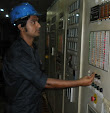Classification of fuses
Fuse is the simplest current interrupting device for protection against excessive currents. Since the invention of first fuse by Edison; several improvements have been made and now a days, a variety of fuses are available. Some fuses also incorporate means for extinguishing the arc that appears when he fuses elements melts. In general fuses may be classified into
- Low voltage fuses
- High voltages fuses
Low voltage fuses
Low voltage fuses can be subdivided into two classes ie,
Semi-closed rewireable fuse
High rupturing capacity (H.R.C) cartridge fuse
Semi-closed rewireable fuse
Rewireable fuse is used where low values of fault current are to be interrupted. It consists of (1) a base and (2)a fuse carrier. The base is of porcelain and carries the fixed contacts to which the incoming and outgoing phase wires are connected. The fuse carrier is also of porcelain and holds the fuse element between its terminals. The fuse element is blown out and the circuit is interrupted in or taken out of the base when desired.
When a fault occur the fuse elements is blown out and the circuit is interrupted. The fuse carrier is taken out and the blown out fuse element is replaced by the new one .The fuse carrier is then reinserted in the base to restore the supply.
High rupturing capacity (H.R.C) cartridge fuse
The primary objection of low and uncertain breaking capacity of semi enclosed rewireable fuses is overcome in H.R.C. cartridge fuse .It consist of a heat resisting ceramic body having metal end caps to which is welded silver current carrying element .The filing material may be chalk, plaster of paris, quartz or marble dust and acts as an arc quenching and cooling medium.
Under normal load condition the fuse element is at a temperature below its melting point .The heat produced in the process vaporize the melted silver element. The chemical reaction between the silver vapour and the filling power results in the formation of a resistance substance which helps in quenching the arc.
High voltage fuses
The low-voltage fuses discussed so far have low normal current rating and breaking capacity. Therefore they cannot be successfully used on modern high voltage circuits. Intensive research by the manufacturers and supply engineers has led to the development of high voltage fuses. Some of the high voltage fuses are
1.0 Cartridge type: This is similar in general construction to the low voltage cartridge type except that special design fractures are incorporated. Some designs employ fuse elements wound in the form of a helix so as to avoid corona effects at higher voltage. On some designs there are two fuses elements in parallel one of low resistance and the other high resistance. Under normal load conditions the low resistance element elements carrier the normal current. When a fault occurs the low resistance element is blown out and the normal current .When a fault occurs the low resistance element is blown out and the high resistance element reduces the short circuits current and finally breaks the circuit. High voltage cartridge fuses are used upto 33KV with breaking capacity of about 8700 A at that voltage. Rating of the order of 2000 A at 606 KV and 11 KV and 50 A at 33KV are also available.
2.0 Liquid types: These fuses are filled with carbon tetrachloride and have the widest range of application to high voltage systems. They may be sued for circuits upto about 100 A rated current on the systems up to 132 KV and may have breaking capacities of the order of 6100 A.
3.0 Metal clad fuses: Metal clad oil immersed fused have been developed with object of providing a substitute for the oil circuit breaker. Such fuses can be used for very high voltage circuits and operate most satisfactorily under short circuit condition approaching their rated capacity.







